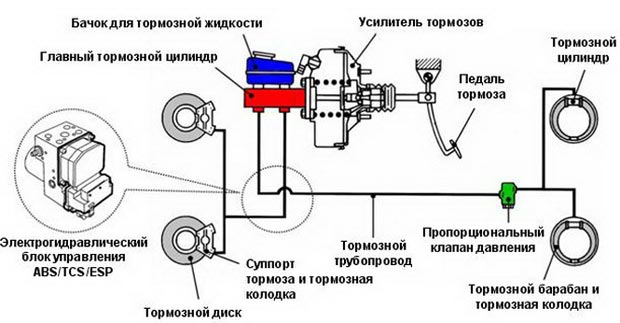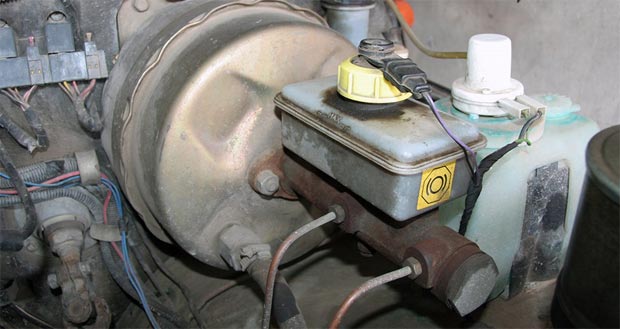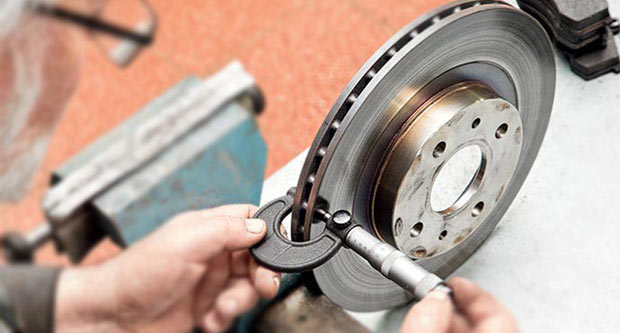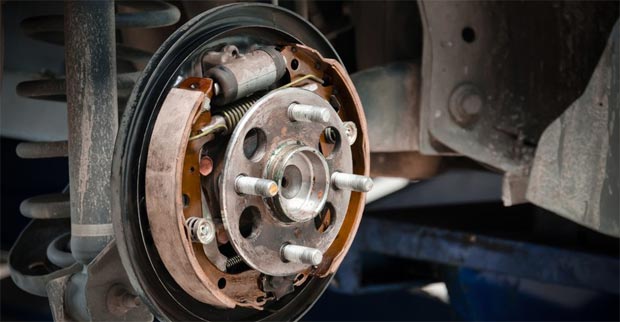
The brake pedal fails, the brake fluid does not leave. Looking for reasons
System air
Perhaps the most common cause of brake pedal failure is air pockets. Brake fluid refers to absolutely incompressible media. Air is easily compressed. And if gas plugs form in the brake system, then when you press the pedal, they simply compress. And the force from the master brake cylinder is only partially transmitted to the calipers or working cylinders.
This phenomenon can be compared with an attempt to move some heavy object, acting on it not directly, but through a soft spring. The spring will be compressed up to a certain point, but the object will not move. So it is with the air brake system: you press the pedal - the pads do not move.
There are several reasons for this. The most common is an old, not changed liquid for a long time. Brake fluid is hygroscopic, meaning it can absorb moisture from the air. When the percentage of water in the liquid exceeds 3,5% of the total volume, it must be replaced. Since when you press the brake pedal, it can boil, which will lead to the formation of traffic jams.


The second reason is micropores in the brake force regulator, line articulations or actuating units (calipers and cylinders). Contrary to popular belief, such pores in some cases are able to suck in air from the environment, but not release brake fluid. Which leads to confusion.
The way out of this situation is simple: you need to replace the fluid if it is outdated, or bleed the system. For each individual car, its own method of pumping the brakes. Basically, two people are needed for this procedure. The first one presses the pedal, the second one opens the fittings on the cylinders (calipers) in turn and bleeds the brake fluid, expelling gas plugs from the system. There are gravity pumping methods in which a partner is not needed.


Watch this video on YouTube
The main brake cylinder is out of order
The main brake cylinder, if the valve system is folded back and the division into circuits, works on the principle of a conventional hydrostatic drive. Like a syringe. We press on the rod - the piston pushes the liquid and feeds it under pressure into the system. If the piston cuffs are worn out, then fluid will flow into the cavity behind it. And this will just lead to a failing pedal and almost absent brakes. This will keep the liquid in the reservoir in place.
There is only one way out of this situation: repair or replacement of the brake cylinder. The repair of this element of the system is now practiced very rarely and is not available for all cars. In addition, repair kits from a set of cuffs do not always solve the problem. Sometimes the surface of the cylinder is damaged by corrosion, which excludes the possibility of repair.


Critical wear of system parts
Another cause of a failing brake pedal can be critical wear on the pads, drums and discs. The fact is that calipers and brake cylinders have a limited piston stroke. And when the pads and cylinders wear out, the pistons have to move further and further to create contact pressure between the pad and the disc (drum). And this requires more and more liquid.
After releasing the pedal, the pistons partially return to their original position. And in order to make them move forward an increased distance the first time, put pressure on the pads and press them against the drum or disc with force, pressing the pedal alone is not enough. The volume of the master brake cylinder is simply not enough to completely fill the system and bring it to working condition. The pedal is soft from the first press. But if you press it a second or third time, it will most likely become elastic, and the brakes will work normally.


In this case, it is necessary to check the condition of the actuating elements and replace them if critical wear is detected.
Also often the cause of a failing pedal is the rear brake pads. On many cars there is no mechanism for their automatic supply as they wear out. And the distance between the pads and the drum is adjusted by tightening the parking brake cables or bringing the eccentrics. And in the free state, the pads return to their original position by a spring.


And it turns out that the pads are worn out, the drums too. The distance between these elements becomes unacceptably large. And in order to overcome this distance, before the pads come into contact with the working surface of the drums, it will be necessary to pump a lot of liquid into the system. One press of the brake pedal will not physically allow this to be done. And there is a feeling of idling of the pedal, its failure.
There is only one way out: to bring the rear pads. In this case, it is necessary to evaluate the degree of production. On some car models, such an accident happens: the pads and drums are so developed that the pistons of the cylinders simply fall out from excessive extension. And this will cause a sharp and complete failure of the brake system.


Watch this video on YouTube
